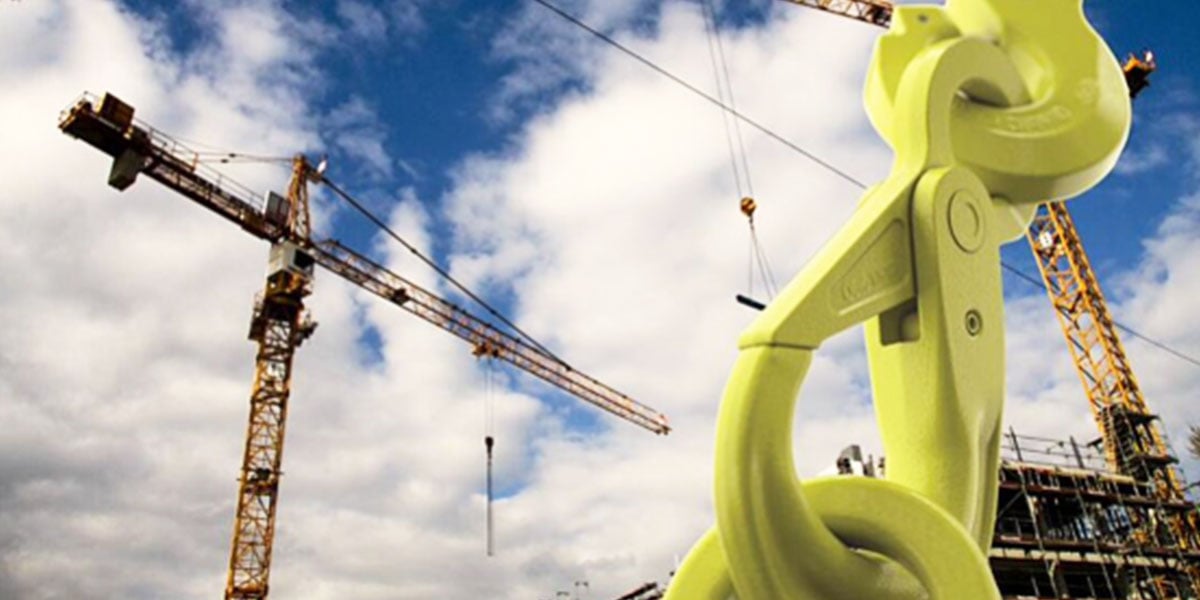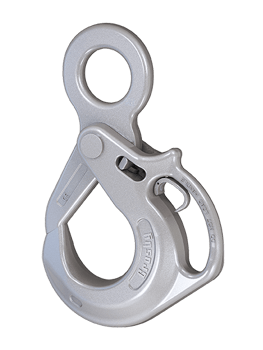Self-locking or safety hooks, as they’re also known as, have changed the lifting industry, but their use is yet to become universal, as Felix Nyberg, global product manager at The Crosby Group, explains.
Self-locking hooks, also commonly known as positive locking hooks or safety hooks, are used in all applications, from industrial manufacturing to offshore oil and gas. There are many clear benefits that end-users have found in switching from sling or standard hooks to self-locking hooks – all contributing to enhanced safety in their lifting operations.

Self-closing design
As the name suggests, self-locking hooks close by themselves as soon as a load is placed in the bowl of the hook and lifting begins. Once it closes, it cannot open again until the load is released from the hook.
The self-locking hook concept was launched as the BK model by the then Gunnebo Industries in the 1960s, primarily to improve safety on construction sites where, previously, hooks were being rigged without any latch at all.
Highly robust latch
Lifting in the construction industry has always been difficult as there is a lot of variability in the loads. Equipment also gets put through a lot of wear as many people are handling the lifting gear and lifting various objects, which often can result in damage to spring latches, like those on a sling hook. This either leads to the lifting gear being taken out of service, potentially delaying work on site, or if good lifting practices are not followed, people may use it without the latch leading to a hazardous lift. The more durable latch on a self-locking hook will last much longer and avoid this happening, while always remaining closed when under load.
Utilized in a broad range of applications
Without listing them all, here are three examples of applications where the safety benefits of using self-locking hooks are widely recognized and used:
- Construction: wire rope slings, chain slings, and as a connection point between a shackle (or hook) and a sling coming from an excavator.
- Industrial manufacturing: chain slings and we are also starting to see more hoists getting refitted with self-locking hooks.
- Offshore: used in forerunners / stingers, which is the line that comes off the crane on the offshore platform to either move loads around the platform or from a supply vessel to the platform.
The Crosby Group recently launched the offshore galvanized BKLK self-locking hook. Working closely with end users in the offshore industry, we developed this hook as a game-changer in durability, and as proof of the exceptional performance of the hooks, they are also third-party type approved by DNV to relevant offshore standards. We’ve continued to innovate on the industry’s first self-locking hook we manufactured, even if the product today looks remarkably like the first one that came off the production line nearly six decades ago.
Self-locking hooks: the history
In the early 1960s, Karl-Axel Wahlström and Stig Lindgren were credited for the first prototype, hand-carved out of wood—a simpler prototyping method than the 3D printing we use today. They called it the ‘BK’ hook, an abbreviation of ‘Byggnadskrok’, which in Swedish is a combination of the word ‘byggnads’, meaning construction, and ‘krok’, meaning hook. The product was patented and released to the market in 1965.
 The BK and Crosby Shur-Loc hooks produced by The Crosby Group today are very similar, both are now designed to avoid fingers getting pinched when opening the hook, which is a common problem with lower quality hooks. Interestingly, the Crosby Shur-Loc and the Gunnebo Industries BK hook use different approaches to solving this issue. The Shur-Loc was designed with an enlarged thumb access, positioned further down and away from the pinch point, while on the BK hook, a latch rotation stop was introduced to stop the latch from pivoting down on the thumb.
The BK and Crosby Shur-Loc hooks produced by The Crosby Group today are very similar, both are now designed to avoid fingers getting pinched when opening the hook, which is a common problem with lower quality hooks. Interestingly, the Crosby Shur-Loc and the Gunnebo Industries BK hook use different approaches to solving this issue. The Shur-Loc was designed with an enlarged thumb access, positioned further down and away from the pinch point, while on the BK hook, a latch rotation stop was introduced to stop the latch from pivoting down on the thumb.
Both may seem like small changes in the design but are extremely important in increasing the worker safety and minimizing downtime from accidents. Pinch point injuries are one of the most common injuries at worksites and designing a product that will help minimize that risk is critical. Other slight adjustments with big impact that have been made over the years include flat sections to allow connection with omega couplers or the GrabiQ system, recessed triggers, and easily replaceable trigger sets.
Today, The Crosby Group offers clevis self-locking hooks that connect directly to a chain sling; ball-bearing swivel hooks that can rotate under load; a Griplatch hook with a latch that connects to the body for improved side-stability and reduced weight; galvanized hooks for severe-weather protection; and even a special self-locking version for skip-loaders.
To further enhance the safety features of the hook, we have added the option of a handle to minimize the pinch risk when manipulating the hook. The handle was developed for high-risk environments such as helicopter lifts or lifts in offshore operations, where bad weather and swells are common.
Another invention that came from the offshore oil and gas industry was the Gunnebo Industries’ branded double latch hook. The secondary, spring-loaded latch acts as a redundant safety feature, making it impossible for the load to slip out, should the main latch come undone due to being violently hit while the load is idle, for example.
Hot-dip galvanization
It’s worth reiterating that the offshore range of self-locking hooks is hot-dip galvanized. The Crosby Group is manufacturing more galvanized chain and rigging gear than ever before, providing products to EN ISO 1461, a hot-dip galvanized specification for coatings on iron and steel. Our products are manufactured and tested to, and above, the highest and most demanding standards globally to extend product life and enhance safety for both personnel and the environment. Galvanizing, the process of applying a protective zinc coating to prevent rusting, offers benefits such as a longer life span, protective coating with high impact and wear resistance, easy inspection, and lower maintenance costs.
In conclusion, while self-locking hooks are used in all markets, from industrial manufacturing to offshore oil and gas, there is an opportunity to bring the benefits that self-locking hooks provide to more job sites worldwide. People tend to choose a sling latch hook for convenience or cost, but with few exceptions the benefits of self-locking hooks far outweigh the drawbacks.
For more information on specific self-locking hook options, see Section 4 of The Crosby Group catalog.

